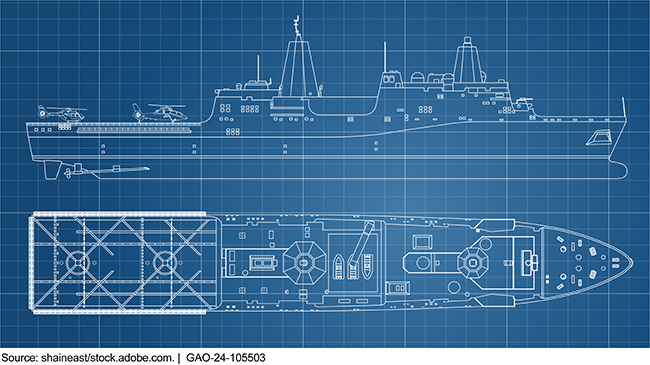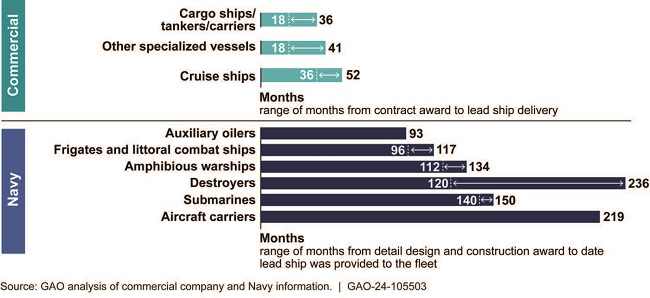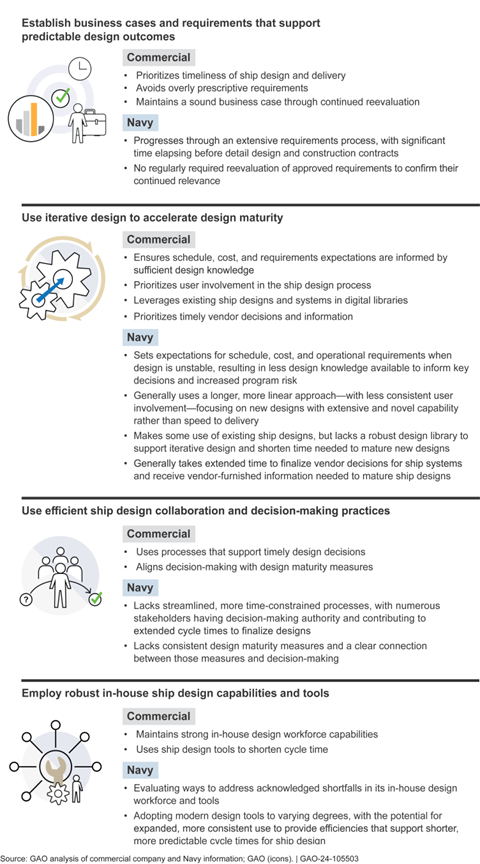Navy Shipbuilding: Increased Use of Leading Design Practices Could Improve Timeliness of Deliveries
Fast Facts
Rapidly changing maritime threats compel the Navy to deliver ships faster. But the Navy falls short on design practices that reduce leading companies' shipbuilding time.
For example, companies:
Use existing ship designs—limiting changes to a section of the ship—to create new designs, allowing companies to stabilize designs sooner and better estimate schedules
Empower a small group of decision makers to use their expertise to get through the design process quickly
In contrast, the Navy often creates new ship designs and has many stakeholders in a lengthy decision-making process.
We recommended the Navy apply these and other leading practices.

Highlights
Why This Matters
Changing maritime threats are pushing the U.S. Navy to increase its pace for designing and delivering new ships. Since 2009, GAO has used leading practices in commercial shipbuilding to evaluate the plans and execution of Navy shipbuilding programs. GAO’s numerous recommendations have spurred Navy action to improve acquisition practices and the use of taxpayer dollars. Yet, the Navy has continued to face persistent challenges in its ability to design and deliver timely, affordable new ships that perform as expected.
Computing power and digital design capabilities have rapidly changed in the 15 years since GAO first identified leading ship design practices. As a result, GAO’s examination of commercial industry’s current practices helps ensure that the activities and performance of the Navy’s shipbuilding programs are evaluated against cutting-edge practices used to design new ships efficiently and effectively.
Key Takeaways
GAO found that leading commercial ship buyers and builders prioritize shorter, predictable periods for design and construction, which result in delivering timely ships that meet current user needs. In contrast, the Navy's approach often results in significantly longer design and construction cycle times for its shipbuilding programs' lead ships.
Comparison of Design and Construction Cycles for Selected Commercial and Navy Ships

Note: For commercial ships, the range of months indicates the shortest and longest typical periods for companies to deliver a ship after contract award. For Navy ships, the range of months for different ship types indicates the shortest and longest periods for the Navy to provide selected lead ships to the fleet since 2007. For Navy programs with a contract prior to the detail design and construction award, the earlier award date represents the start of the cycle.
Key differences between commercial companies' and the Navy's ship design practices contribute to the slower pace and less predictable cost, schedule, and performance outcomes for Navy shipbuilding programs. Leading design practices involve
- effective management of a ship's business case—a reflection of the balance of customer needs and the resources needed to develop and produce the ship; and
- focus on efficiently maturing new ship designs to better inform decisions on schedule, cost, and performance. This includes using consistent, meaningful design maturity measures to determine readiness to move from design to construction.
GAO Comparison of Leading Ship Design Practices for Commercial Companies and U.S. Navy

How GAO Did This Study
A conference report directed GAO to examine ship design practices. This report assesses (1) the leading design practices used by commercial ship buyers and builders to inform their understanding of design maturity and readiness for construction, and (2) how the Navy’s ship design practices compare to the leading practices in commercial ship design. To address these objectives. GAO interviewed and reviewed documentation from four commercial ship buyers and five shipbuilders—builders generally also design the ships. GAO selected these companies using criteria reflective of commercial success in designing, building, and buying ships relatable to Navy ships. GAO also reviewed its prior work on leading practices for shipbuilding and product development. In addition, GAO reviewed documentation and interviewed representatives from the Navy and selected Navy shipbuilders, as well as reviewed prior work on Navy shipbuilding program efforts. Based on the results of these activities, GAO compared the ship design practices used by the Navy with leading commercial practices.
Recommendations
GAO is raising to the attention of Congress three matters for its consideration regarding reporting and certification requirements. The matters would enable Congress to gain additional information on design maturity for Navy shipbuilding programs. GAO is also making eight recommendations to the Secretary of the Navy, which are intended to support improvements to the Navy’s design approach, decision-making practices, and design capabilities that facilitate more timely, predictable outcomes for its shipbuilding programs. The Navy agreed with seven recommendations and partially agreed with one recommendation. GAO continues to believe that all eight recommendations should be fully implemented.
Matter for Congressional Consideration
| Matter | Status | Comments |
|---|---|---|
| Congress should consider updating statutory certification and production readiness review reporting requirements for Navy shipbuilding programs under section 8669c of title 10 United States Code, to require certification of the completion of basic and functional design in 3D modeling and the positioning and routing of all major distributive systems prior to the start of construction (consistent with leading industry practices in ship design). (Matter for Consideration 1) | When we confirm what actions the agency has taken in response to this recommendation, we will provide updated information. | |
| Congress should consider requiring, as part of section 8669c of title 10, United States Code, that the Navy certify that detail design will be completed for each block of a ship's construction before beginning construction of that block. (Matter for Consideration 2) | When we confirm what actions the agency has taken in response to this recommendation, we will provide updated information. | |
| Congress should consider requiring, as part of section 8669c of title 10, United States Code, that the Navy report on the degree of vendor-furnished information completeness supporting the overall maturity and stability of a ship's design before beginning construction. (Matter for Consideration 3) | When we confirm what actions the agency has taken in response to this recommendation, we will provide updated information. |
Recommendations for Executive Action
| Agency Affected | Recommendation | Status |
|---|---|---|
| Department of the Navy | The Secretary of the Navy should ensure that each shipbuilding program reevaluates validated requirements in capability development documents before the start of construction for individual ships and periodically during ship construction to confirm their continued relevance and identify any appropriate changes. (Recommendation 1) |
When we confirm what actions the agency has taken in response to this recommendation, we will provide updated information.
|
| Department of the Navy | The Secretary of the Navy should ensure that shipbuilding programs complete functional design for new ships before awarding detail design and construction contracts. (Recommendation 2) |
When we confirm what actions the agency has taken in response to this recommendation, we will provide updated information.
|
| Department of the Navy | The Secretary of the Navy should ensure that the design teams for new ship designs include user representation, such as current or recent operators and engineers from the Navy's fleet, to provide consistent, direct user input in the design review process and inform decision-making. (Recommendation 3) |
When we confirm what actions the agency has taken in response to this recommendation, we will provide updated information.
|
| Department of the Navy | The Secretary of the Navy should develop a robust digital ship design library to enhance the Navy's ability to leverage existing designs and expedite design and construction. (Recommendation 4) |
When we confirm what actions the agency has taken in response to this recommendation, we will provide updated information.
|
| Department of the Navy | The Secretary of the Navy should—in coordination with Navy shipbuilders—evaluate opportunities to accelerate the receipt of reliable vendor-furnished information to support earlier design maturity for new ships. (Recommendation 5) |
When we confirm what actions the agency has taken in response to this recommendation, we will provide updated information.
|
| Department of the Navy | The Secretary of the Navy should evaluate the response timelines for reviewing and approving design products and the sufficiency of the Navy's resources supporting design review and decision-making processes to identify any opportunities to shorten design review timelines. (Recommendation 6) |
When we confirm what actions the agency has taken in response to this recommendation, we will provide updated information.
|
| Department of the Navy | The Secretary of the Navy should establish—and regularly update, as needed— guidance outlining the information and evaluation methodology used to certify the completion of basic and functional design prior to a ship's construction start for any major shipbuilding program, to include the Navy's explanation of what design activities and outputs must be accomplished to meet the statutory requirement for completion of a ship's basic and functional design. (Recommendation 7) |
When we confirm what actions the agency has taken in response to this recommendation, we will provide updated information.
|
| Department of the Navy | The Secretary of the Navy should evaluate opportunities to increase the use of modern design tools, including digital twinning and virtual or augmented reality. (Recommendation 8) |
When we confirm what actions the agency has taken in response to this recommendation, we will provide updated information.
|
